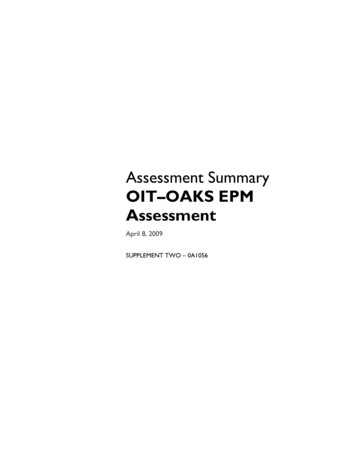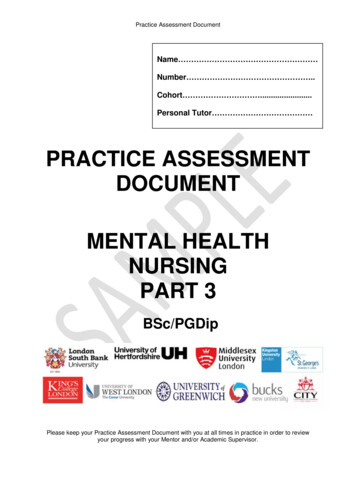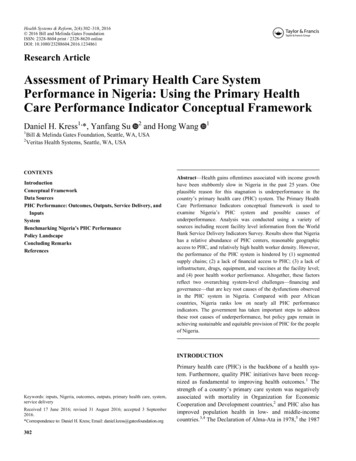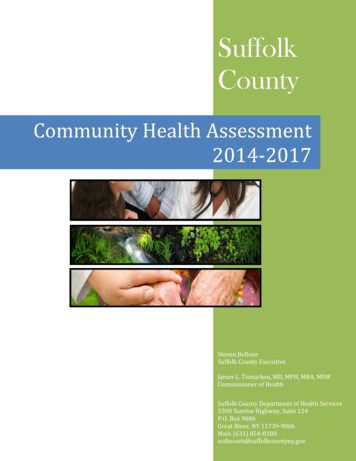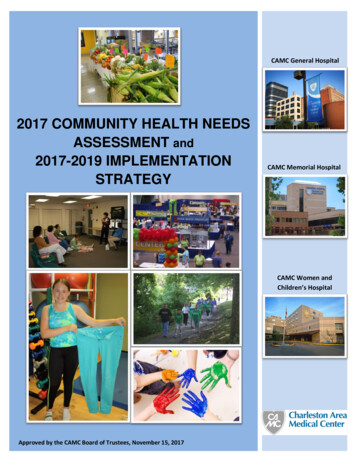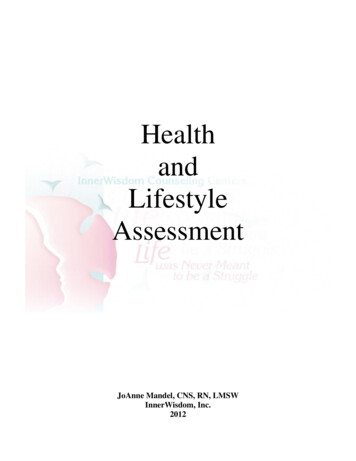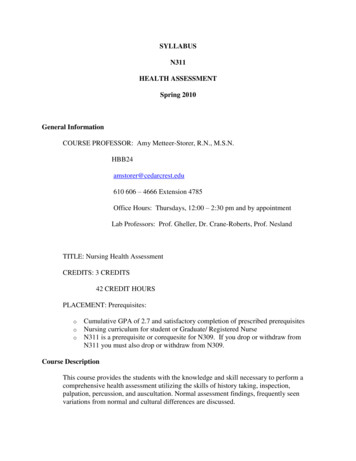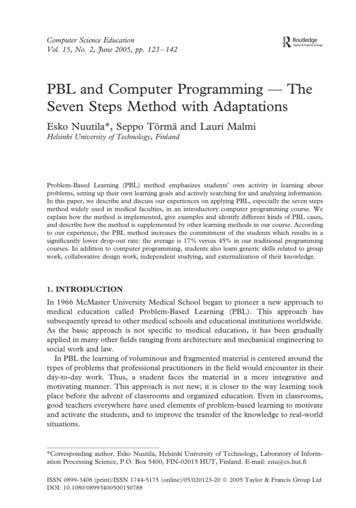
Transcription
Steps of Health Assessment
Five key phases of assessment1.2.3.4.5.Collecting dataValidating (verifying) dataOrganizing dataAnalyze the dataIdentifying patterns/testing firstimpressions6. Reporting and recording dataMaria Carmela L. Domocmat, RN, MSN
Collecting data Subjective and Objective data– Aids critical thinking because eachcomplements and clarifies the other.– Subjective data – what the personstates verbally or in writing– Objective data – what you observe– S – S: Subjective Stated– O – O: Objective ObservedMaria Carmela L. Domocmat, RN, MSN
Collecting subjective datasubjective data are data that are elicitedand verified only by the clientobtained through interviewingMaria Carmela L. Domocmat, RN, MSN
Includes Complete HealthHistoryBiographical dataReasons for seekinghealth careHistory of PresentHealth concernsPast health historyFamily health historyReview of bodysystems (especiallyfor current healthproblems)Lifestyle and healthpractices profileDevelopmental levelMaria Carmela L. Domocmat, RN, MSN
Collecting objective data Data directly observed or detectable by theexaminer or can be tested by using an acceptedstandardMaria Carmela L. Domocmat, RN, MSN
Collecting objective data Data include:physical characteristicsbody functionsappearancebehaviormeasurementresults of laboratory testingMaria Carmela L. Domocmat, RN, MSN
Objective data are sometimes calledsigns, Subjective data are sometimes calledsymptoms.Maria Carmela L. Domocmat, RN, MSN
Subjective data:– States, “I feel like my heart is racing.” Objective data:– Pulse 150 beats, regular, and strong.Maria Carmela L. Domocmat, RN, MSN
The objective data support the subjectivedata: what you observe confirms what theperson is stating.Maria Carmela L. Domocmat, RN, MSN
The subjective and objective data youidentify act as cues. Cues are data that prompt you to get an initialimpression about patterns of health or illness. The cues may lead you to infer (suspect). Inference – the conclusion drawn about the cue: itis how you interpret or perceive a cue.Maria Carmela L. Domocmat, RN, MSN
Cues – subjective or objective dataobserved by the nurse; it is what the clientsays, or what the nurse can see, hear,feel, smell or measure.Maria Carmela L. Domocmat, RN, MSN
Inferences – the nurse interpretation orconclusion based on the cues. Example: red, swollen wound infectedwound; Dry skin dehydratedMaria Carmela L. Domocmat, RN, MSN
ACTIVITYMaria Carmela L. Domocmat, RN, MSN
Subjective and Objective Data Read the following case studies andanswer the subsequent questions.Maria Carmela L. Domocmat, RN, MSN
Case study 1Mr. Michaels is 51 years old. He was admitted two days ago with chestpain. His physician has ordered the following studies: electrocardiogram,chest x-ray, and complete blood studies including a blood sugar. Thesestudies were just posted on the chart. When you talk with him, hestates, “I feel much better today – no more pain. It is a relief to get ridof the discomfort.” You think he appears a little tired or weary – heseems to be talking slowly and sighs more often than you would thinkis necessary. When his wife comes to see him, she is cheerful with him,but confides in you he seems depressed or something. His vital signsare: T. 98.8, P: 74 and regular, R: 22; BP: 140/90.Maria Carmela L. Domocmat, RN, MSN
1.2.List the subjective data noted for Mr.MichaelsList the objective data noted for Mr.MichaelsMaria Carmela L. Domocmat, RN, MSN
The subjective data noted for Mr.MichaelsPatient states: “No pain today” Pain relieved - “feels relieved” Wife states he seems depressed.Maria Carmela L. Domocmat, RN, MSN
The objective data noted for Mr. Michaels Lab resultsTalking slowlySighsVital signsAppears tired, wearyPatient’s ageMaria Carmela L. Domocmat, RN, MSN
Case Study 2Mrs. Rochester is a 33 year old mother of two young children. She isadmitted with the medical diagnosis of diabetes. Today you enter room,and she states, “The doctor says I have diabetes. I can’t see how I couldhave diabetes. No one in my family has diabetes. I feel fine—I don’t seehow I can make myself change the way I eat. Dieting drives me crazy –that’s why I weighed 190 pounds when you weighed me. On furtherquestioning, she admits she has been feeling unusually tired lately, andshe does seem to have to urinate more than usual. You check her chartand note her fasting blood sugar was elevated at 144. Her vital signsare: T: 98.10 F; P: 88 and regular; R: 24; BP: 144/88.Maria Carmela L. Domocmat, RN, MSN
1.2.List the subjective data noted for Mrs.Rochester.List the objective data noted for Mrs.Rochester.Maria Carmela L. Domocmat, RN, MSN
The subjective data noted for Mrs.Rochester. Patient states:“I can’t believe I have diabetes.”“I don’t think I can change eating habits.”Verbalization of feeling tired latelyIncreased urination is offered as a concernMaria Carmela L. Domocmat, RN, MSN
The objective data noted for Mrs.Rochester. 33 years oldMother of 2WeightDiagnosis of diabetesBlood sugarVital signsMaria Carmela L. Domocmat, RN, MSN
Identify the client data as objectiveor subjective.Mrs. Jones says,” I can’tsleep.”Mrs. Jones is breathing rapidly.Client has a pulse of 104.The client states he has a hipfracture.Client states, “I am cold.”Surgical dressing is dry.Client says she cannot void.Client is coughing.Client walks with a limp.Wheezes are auscultated.Maria Carmela L. Domocmat, RN, MSN
Identify the client data as objectiveor subjective.SMrs. Jones says,” I can’tsleep.”O Mrs. Jones is breathing rapidly.O Client has a pulse of 104.SSO Surgical dressing is dry.Client states, “I am cold.”SThe client states he has a hipfracture.Client says she cannot void.O Client is coughing.O Client walks with a limp.O Wheezes are auscultated.Maria Carmela L. Domocmat, RN, MSN
Validation of data a crucial part of assessment that oftenoccurs along with collection of subjectiveand objective dataMaria Carmela L. Domocmat, RN, MSN
Validation of data the act of “double-checking” or verifyingdata to confirm that it is accurate andcomplete.Maria Carmela L. Domocmat, RN, MSN
Purposes of data validation: ensure that data collection is complete ensure that objective and subjective dataagree obtain additional data that may have beenoverlooked avoid jumping to conclusion differentiate cues and inferencesMaria Carmela L. Domocmat, RN, MSN
Validating (verifying) dataMaria Carmela L. Domocmat, RN, MSN
Validating (verifying) data Helps avoid:– Making assumptions– Missing pertinent information– Misunderstanding situations– Jumping to conclusions or focusing in thewrong direction– Making errors in problem identificationMaria Carmela L. Domocmat, RN, MSN
Guidelines:– Data that can be measured accurately can beaccepted as factual (e.g. height, weight,laboratory study results– Data that someone else observes (indirectdata) may or may not be true. When theinformation is critical, verify it by directlyobserving and interviewing the patientyourself.Maria Carmela L. Domocmat, RN, MSN
– Validate questionable information by using thefollowing techniques, as appropriate: Double-check that your equipment is workingcorrectly Recheck your own data (e.g. take a client’s BP inthe opposite arm or 10 min later) Look for factors that may alter accuracy Ask someone else, preferably an expert, to collectthe same dataMaria Carmela L. Domocmat, RN, MSN
Double-check information that is extremelyabnormal or inconsistent with patient cues(e.g. use two scale to check an infant whoappears too much heavier or lighter, orrepeat extremely high or low lab result) Compare subjective and objective data tosee if what the person is stating iscongruent with what you observeMaria Carmela L. Domocmat, RN, MSN
Clarify statements and verify yourinferences (e.g. “To me, you look tired”) Compare your impressions with those ofother key members of the health careteam.Maria Carmela L. Domocmat, RN, MSN
Organizing (clustering) dataMaria Carmela L. Domocmat, RN, MSN
Organizing (clustering) data Clustering the data together is a criticalthinking principle that enhances yourability to get a clear picture of the client’shealth status.Maria Carmela L. Domocmat, RN, MSN
Ways to cluster data:– Clustering data according to a nursing model– helps to identify nursing diagnoses andproblems Henderson’s Components of Nursing CareGordon’s Functional Health PatternsNANDA’s human response patternsMaslow’s theories Maria Carmela L. Domocmat, RN, MSN
Ways to cluster data: Clustering data according to body systems– helps to identify data that may indicatemedical problemsMaria Carmela L. Domocmat, RN, MSN
Note: It is important to do both in order tofacilitate recognition of both possiblenursing problems and medical problems.Maria Carmela L. Domocmat, RN, MSN
If you cluster data according to bodysystem only, you are likely to miss keyinformation that helps you identify nursingdiagnoses.Maria Carmela L. Domocmat, RN, MSN
If you cluster data according to a nursingmodel only, you may group your data insuch a way that medical problems may notbe obvious.Maria Carmela L. Domocmat, RN, MSN
Assessment tools– Gordon’s Functional Health Patterns– Katz Index of Independence– Barthel Index– Newborn – APGAR Scoring System– Infants and Children – MMDSTMaria Carmela L. Domocmat, RN, MSN
Gordon’s Functional HealthPatterns: Health perception-health management pattern.Nutritional-metabolic patternElimination patternActivity-exercise patternSleep-rest patternCognitive-perceptual patternSelf-perception-concept patternRole-relationship patternSexuality-reproductive patternCoping-stress tolerance patternValue-belief patternMaria Carmela L. Domocmat, RN, MSN
Analyze dataMaria Carmela L. Domocmat, RN, MSN
Analyze data compare data against standard andidentify significant cues. Standard/normare generally accepted measurements,model, pattern:Maria Carmela L. Domocmat, RN, MSN
Analyze data Ex: Normal vital signs, standard Weightand Height, normal laboratory/diagnosticvalues, normal growth and developmentpatternMaria Carmela L. Domocmat, RN, MSN
Identifying patterns/testing firstimpressionsMaria Carmela L. Domocmat, RN, MSN
Identifying patterns/testing firstimpressions After clustering data into groups ofrelated information You get some initial impressions ofpatterns of human functioning. But you must test these impressionsand decide if the patterns really areas they appearMaria Carmela L. Domocmat, RN, MSN
Testing first impressions involves– deciding what’s relevant– making tentative decisions about what thedata may suggest,– focusing assessment to gain more informationto fully understand the situations at handMaria Carmela L. Domocmat, RN, MSN
like the puzzle analogy – you put some ofthe puzzle pieces together and you thinkyou know what the picture looks likeMaria Carmela L. Domocmat, RN, MSN
Reporting and recording data orDocumentation of dataMaria Carmela L. Domocmat, RN, MSN
Reporting and recording data Reporting abnormal data in a timelyfashion expedites diagnosis and treatmentof urgent problems Recording data in a timely fashionpromotes continuity, accuracy, and criticalthinkingMaria Carmela L. Domocmat, RN, MSN
Documentation of data an important step of assessment becauseit forms the database for the entire nursingprocess and provides data for all othermembers of the health care teamMaria Carmela L. Domocmat, RN, MSN
Documentation of data thorough and accurate documentation isvital to ensure valid conclusions are madewhen the data are analyzed in the secondstep of the nursing processMaria Carmela L. Domocmat, RN, MSN
Documentation of data nurse records all data collected about theclient’s health status data are recorded in a factual manner notas interpreted by the nurse record subjective data in client’s word;restating in other words what client saysmight change its original meaning.Maria Carmela L. Domocmat, RN, MSN
Documentation of data use anatomic landmarks in descriptions Ex: 1½ x 2 ½ wound located 2 ½ inches below theumbilicus at the MCLMaria Carmela L. Domocmat, RN, MSN
Documentation of data use anatomic landmarks in descriptions Ex: 1½ x 2 ½ wound located 2 ½ inches below theumbilicus at the MCLMaria Carmela L. Domocmat, RN, MSN
Documentation of data pinpoint findings by position on clock»left breast, dominant 3cm mass at 1 o'clockposition, 2 cm from theareolar borderMaria Carmela L. Domocmat, RN, MSN
Maria Carmela L. Domocmat, RN, MSN
End result of assessment formulation of nursing diagnoses (wellness,risk, or actual) that require nursing care, the identification of collaborative problemsthat require interdisciplinary care, and» the identification of medicalproblems that requireimmediate referralMaria Carmela L. Domocmat, RN, MSN
Gordon’s Functional Health Patterns: Health perception-health management pattern. Nutritional-metabolic pattern Elimination pattern Activity-exercise pattern Sleep -rest pattern Cognitive-perceptual pattern Self-perception-concept pattern Role-relationship pattern Sexuality-reproductive patternFile Size: 353KBPage Count: 60

